WEL118 Report: Australian Red Cross - Social and Economic Factors
VerifiedAdded on 2023/03/17
|7
|1911
|58
Report
AI Summary
This report provides an in-depth analysis of the Australian Red Cross, a prominent NGO, and its contributions to human welfare within the Australian context. The research begins with an executive summary and an introduction to human service organizations, highlighting the Red Cross's position as an auxiliary to the government. The report details the organization's profile, including its founding, mission, and core principles, as well as its diverse range of services such as international aid, emergency support, and community programs. The core of the report examines the impact of social policies and economic frameworks on the Red Cross's operations, addressing advocacy, diversity, food security, gender equality, and migration policies. It explores how these policies influence the organization's ability to address humanitarian issues and support vulnerable populations. The report also discusses the challenges faced by NGOs, including funding models, bureaucratic inefficiencies, and the balancing of donor priorities with the needs of marginalized communities. Finally, the report concludes by emphasizing the importance of accountability, equity, and collaboration between NGOs and government bodies to achieve common goals in human well-being. The report also includes a list of references for further research and insights into the subject.
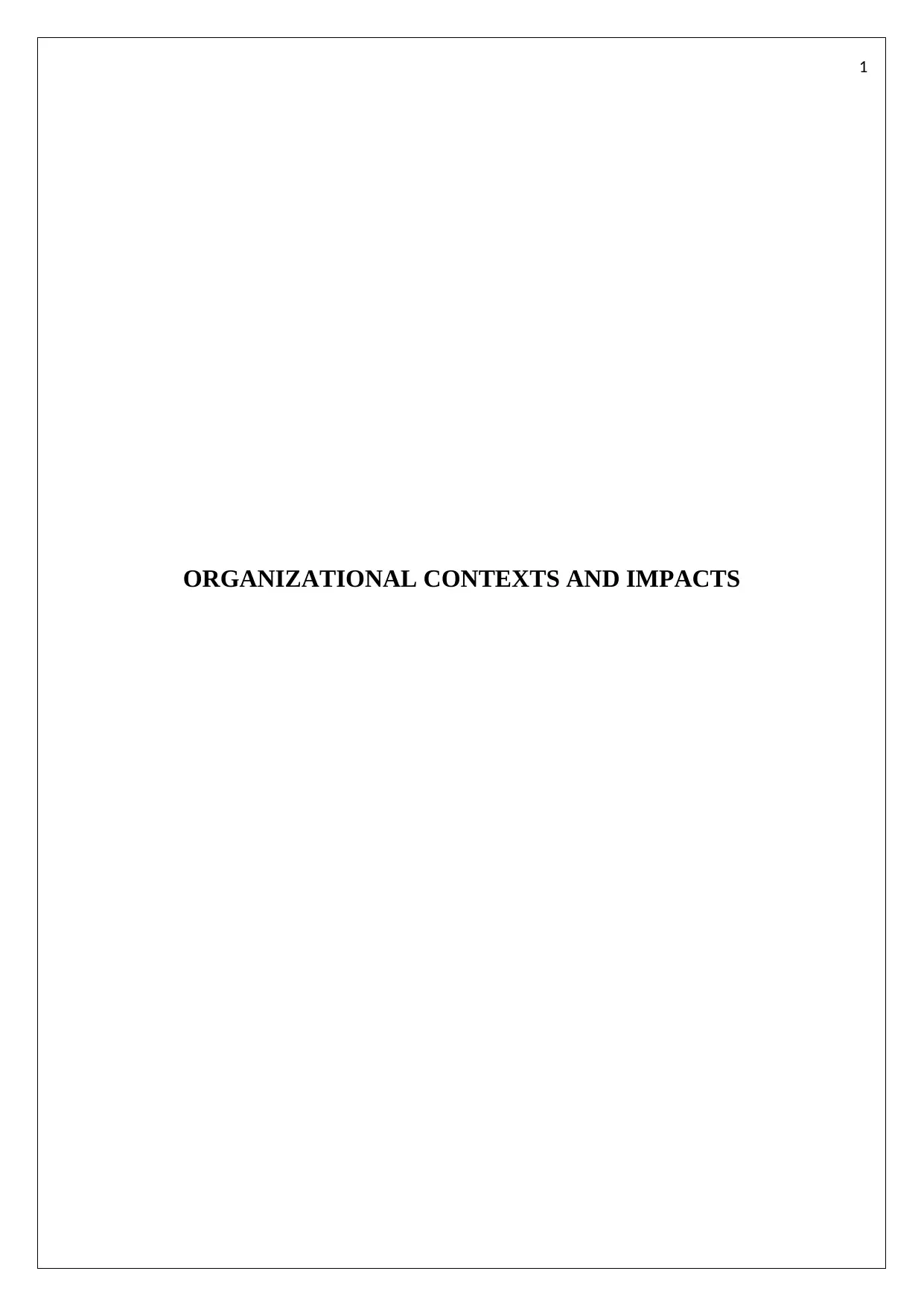
1
ORGANIZATIONAL CONTEXTS AND IMPACTS
ORGANIZATIONAL CONTEXTS AND IMPACTS
Paraphrase This Document
Need a fresh take? Get an instant paraphrase of this document with our AI Paraphraser
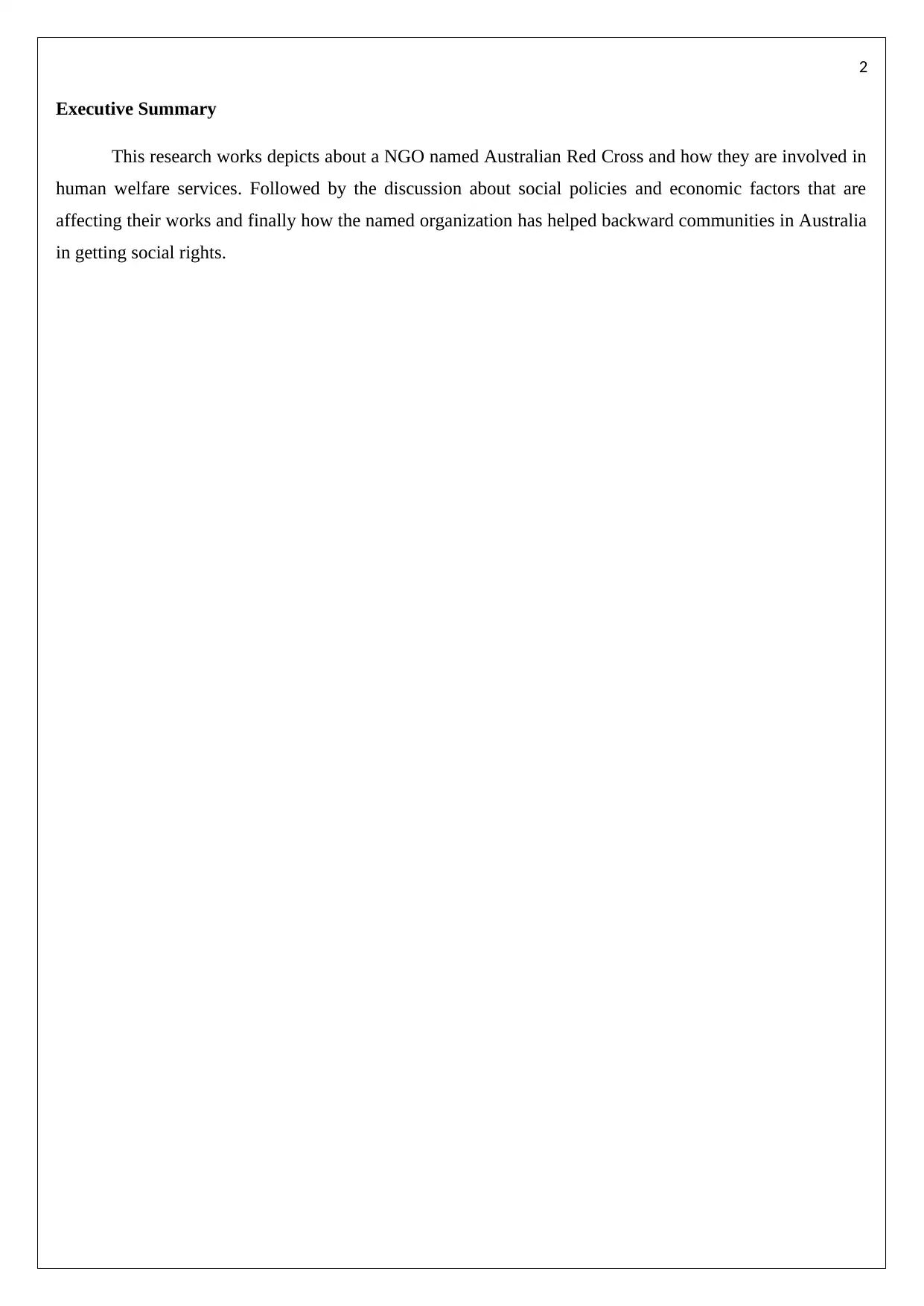
2
Executive Summary
This research works depicts about a NGO named Australian Red Cross and how they are involved in
human welfare services. Followed by the discussion about social policies and economic factors that are
affecting their works and finally how the named organization has helped backward communities in Australia
in getting social rights.
Executive Summary
This research works depicts about a NGO named Australian Red Cross and how they are involved in
human welfare services. Followed by the discussion about social policies and economic factors that are
affecting their works and finally how the named organization has helped backward communities in Australia
in getting social rights.
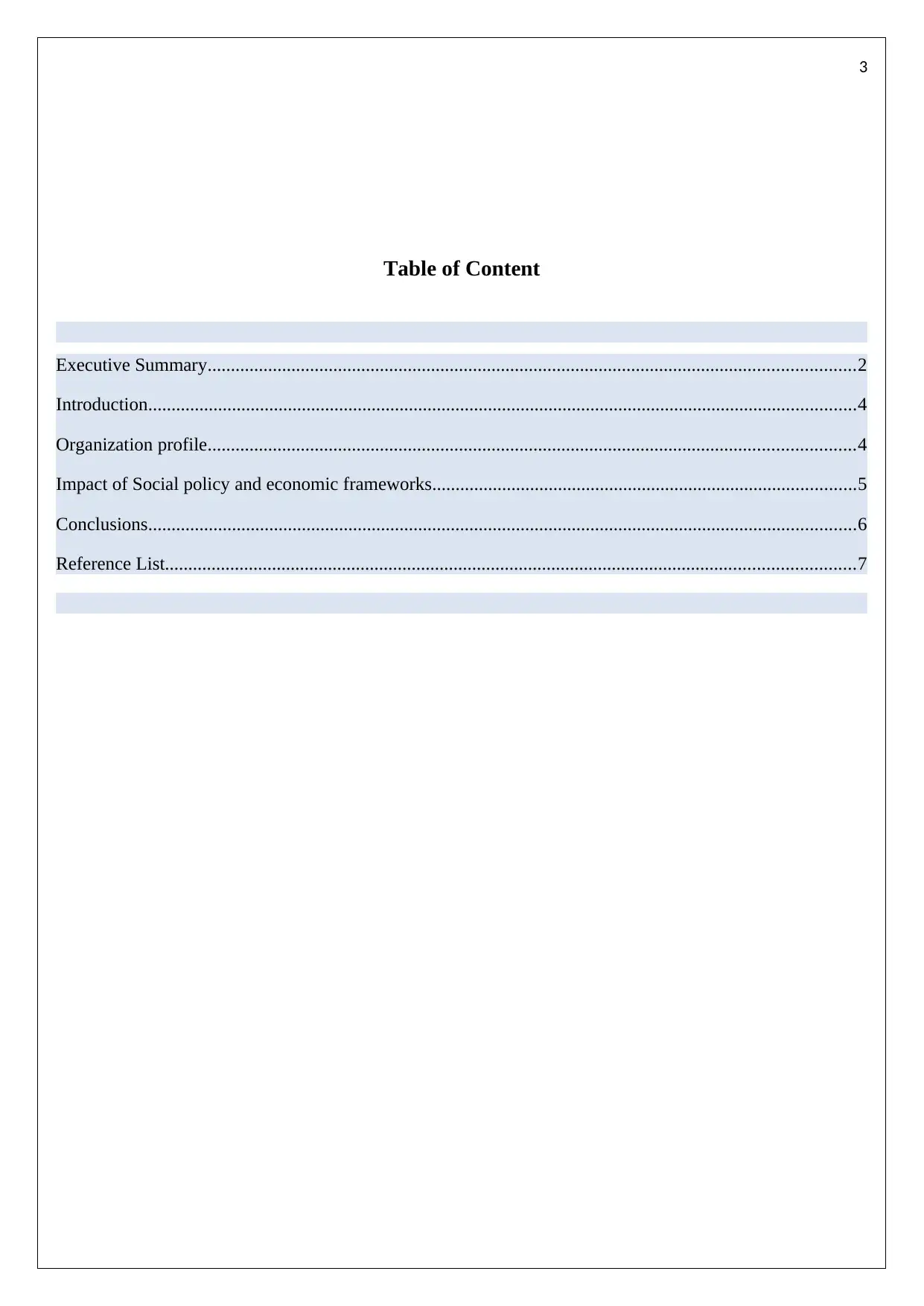
3
Table of Content
Executive Summary...........................................................................................................................................2
Introduction........................................................................................................................................................4
Organization profile...........................................................................................................................................4
Impact of Social policy and economic frameworks...........................................................................................5
Conclusions........................................................................................................................................................6
Reference List....................................................................................................................................................7
Table of Content
Executive Summary...........................................................................................................................................2
Introduction........................................................................................................................................................4
Organization profile...........................................................................................................................................4
Impact of Social policy and economic frameworks...........................................................................................5
Conclusions........................................................................................................................................................6
Reference List....................................................................................................................................................7
⊘ This is a preview!⊘
Do you want full access?
Subscribe today to unlock all pages.

Trusted by 1+ million students worldwide
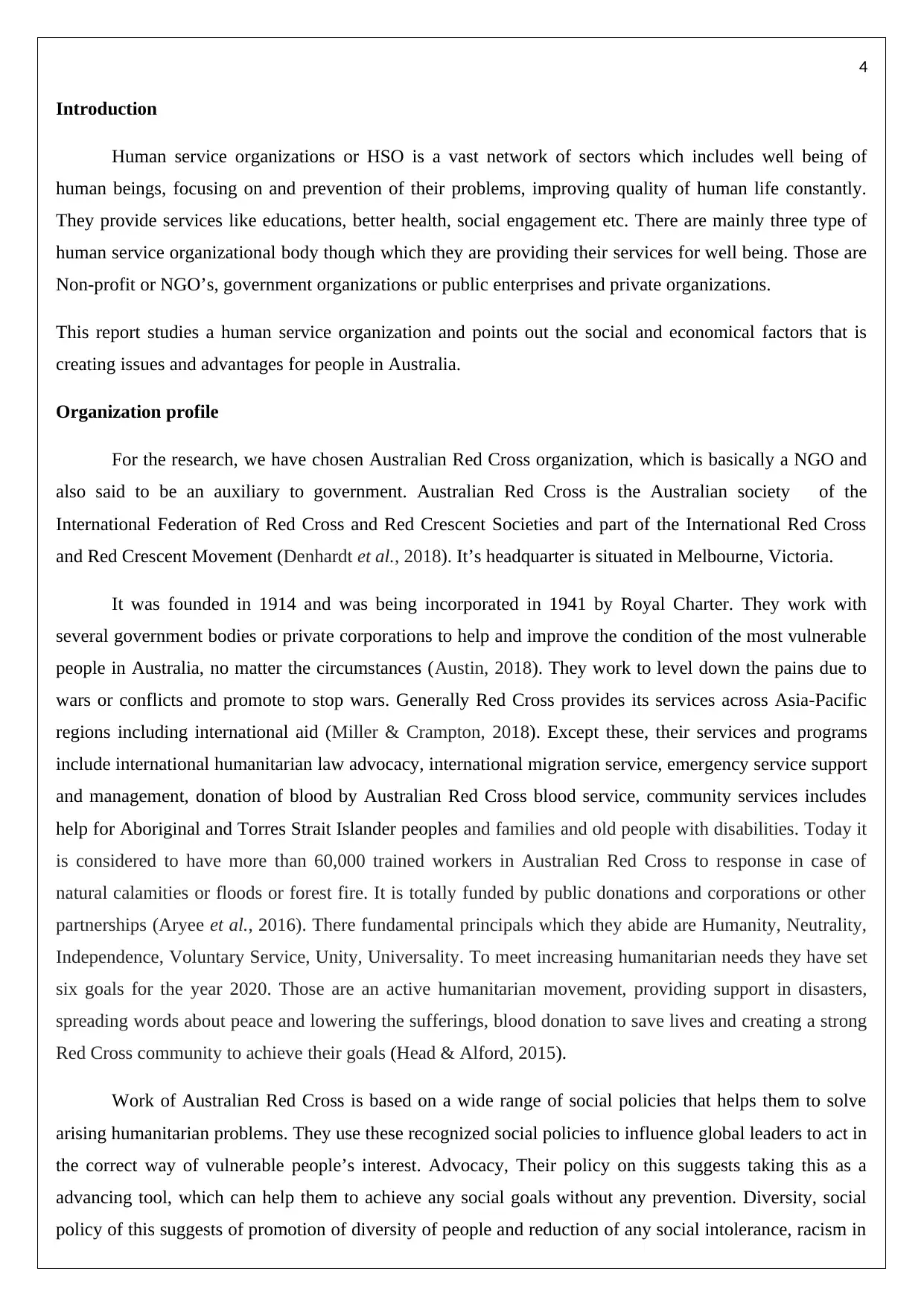
4
Introduction
Human service organizations or HSO is a vast network of sectors which includes well being of
human beings, focusing on and prevention of their problems, improving quality of human life constantly.
They provide services like educations, better health, social engagement etc. There are mainly three type of
human service organizational body though which they are providing their services for well being. Those are
Non-profit or NGO’s, government organizations or public enterprises and private organizations.
This report studies a human service organization and points out the social and economical factors that is
creating issues and advantages for people in Australia.
Organization profile
For the research, we have chosen Australian Red Cross organization, which is basically a NGO and
also said to be an auxiliary to government. Australian Red Cross is the Australian society of the
International Federation of Red Cross and Red Crescent Societies and part of the International Red Cross
and Red Crescent Movement (Denhardt et al., 2018). It’s headquarter is situated in Melbourne, Victoria.
It was founded in 1914 and was being incorporated in 1941 by Royal Charter. They work with
several government bodies or private corporations to help and improve the condition of the most vulnerable
people in Australia, no matter the circumstances (Austin, 2018). They work to level down the pains due to
wars or conflicts and promote to stop wars. Generally Red Cross provides its services across Asia-Pacific
regions including international aid (Miller & Crampton, 2018). Except these, their services and programs
include international humanitarian law advocacy, international migration service, emergency service support
and management, donation of blood by Australian Red Cross blood service, community services includes
help for Aboriginal and Torres Strait Islander peoples and families and old people with disabilities. Today it
is considered to have more than 60,000 trained workers in Australian Red Cross to response in case of
natural calamities or floods or forest fire. It is totally funded by public donations and corporations or other
partnerships (Aryee et al., 2016). There fundamental principals which they abide are Humanity, Neutrality,
Independence, Voluntary Service, Unity, Universality. To meet increasing humanitarian needs they have set
six goals for the year 2020. Those are an active humanitarian movement, providing support in disasters,
spreading words about peace and lowering the sufferings, blood donation to save lives and creating a strong
Red Cross community to achieve their goals (Head & Alford, 2015).
Work of Australian Red Cross is based on a wide range of social policies that helps them to solve
arising humanitarian problems. They use these recognized social policies to influence global leaders to act in
the correct way of vulnerable people’s interest. Advocacy, Their policy on this suggests taking this as a
advancing tool, which can help them to achieve any social goals without any prevention. Diversity, social
policy of this suggests of promotion of diversity of people and reduction of any social intolerance, racism in
Introduction
Human service organizations or HSO is a vast network of sectors which includes well being of
human beings, focusing on and prevention of their problems, improving quality of human life constantly.
They provide services like educations, better health, social engagement etc. There are mainly three type of
human service organizational body though which they are providing their services for well being. Those are
Non-profit or NGO’s, government organizations or public enterprises and private organizations.
This report studies a human service organization and points out the social and economical factors that is
creating issues and advantages for people in Australia.
Organization profile
For the research, we have chosen Australian Red Cross organization, which is basically a NGO and
also said to be an auxiliary to government. Australian Red Cross is the Australian society of the
International Federation of Red Cross and Red Crescent Societies and part of the International Red Cross
and Red Crescent Movement (Denhardt et al., 2018). It’s headquarter is situated in Melbourne, Victoria.
It was founded in 1914 and was being incorporated in 1941 by Royal Charter. They work with
several government bodies or private corporations to help and improve the condition of the most vulnerable
people in Australia, no matter the circumstances (Austin, 2018). They work to level down the pains due to
wars or conflicts and promote to stop wars. Generally Red Cross provides its services across Asia-Pacific
regions including international aid (Miller & Crampton, 2018). Except these, their services and programs
include international humanitarian law advocacy, international migration service, emergency service support
and management, donation of blood by Australian Red Cross blood service, community services includes
help for Aboriginal and Torres Strait Islander peoples and families and old people with disabilities. Today it
is considered to have more than 60,000 trained workers in Australian Red Cross to response in case of
natural calamities or floods or forest fire. It is totally funded by public donations and corporations or other
partnerships (Aryee et al., 2016). There fundamental principals which they abide are Humanity, Neutrality,
Independence, Voluntary Service, Unity, Universality. To meet increasing humanitarian needs they have set
six goals for the year 2020. Those are an active humanitarian movement, providing support in disasters,
spreading words about peace and lowering the sufferings, blood donation to save lives and creating a strong
Red Cross community to achieve their goals (Head & Alford, 2015).
Work of Australian Red Cross is based on a wide range of social policies that helps them to solve
arising humanitarian problems. They use these recognized social policies to influence global leaders to act in
the correct way of vulnerable people’s interest. Advocacy, Their policy on this suggests taking this as a
advancing tool, which can help them to achieve any social goals without any prevention. Diversity, social
policy of this suggests of promotion of diversity of people and reduction of any social intolerance, racism in
Paraphrase This Document
Need a fresh take? Get an instant paraphrase of this document with our AI Paraphraser
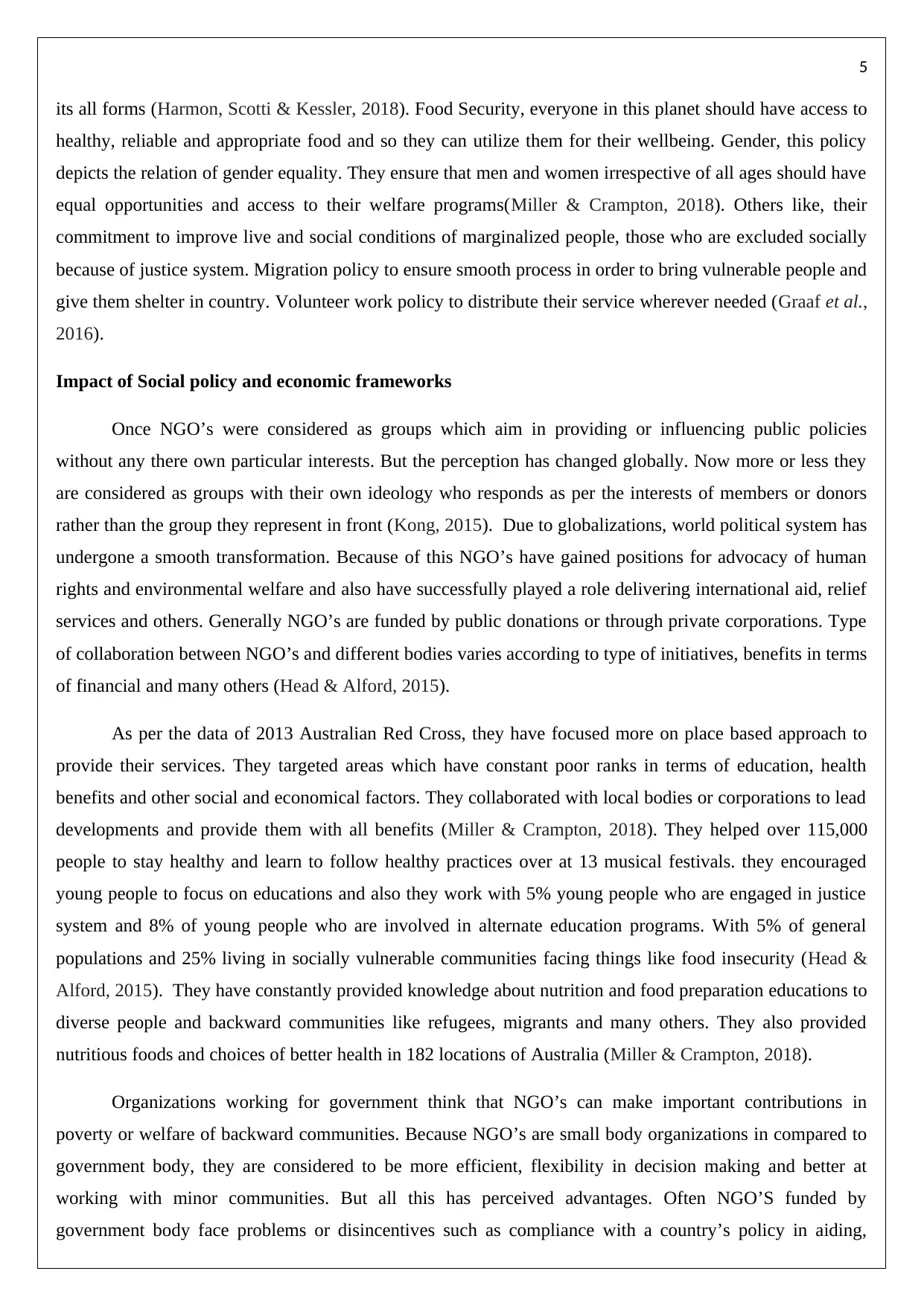
5
its all forms (Harmon, Scotti & Kessler, 2018). Food Security, everyone in this planet should have access to
healthy, reliable and appropriate food and so they can utilize them for their wellbeing. Gender, this policy
depicts the relation of gender equality. They ensure that men and women irrespective of all ages should have
equal opportunities and access to their welfare programs(Miller & Crampton, 2018). Others like, their
commitment to improve live and social conditions of marginalized people, those who are excluded socially
because of justice system. Migration policy to ensure smooth process in order to bring vulnerable people and
give them shelter in country. Volunteer work policy to distribute their service wherever needed (Graaf et al.,
2016).
Impact of Social policy and economic frameworks
Once NGO’s were considered as groups which aim in providing or influencing public policies
without any there own particular interests. But the perception has changed globally. Now more or less they
are considered as groups with their own ideology who responds as per the interests of members or donors
rather than the group they represent in front (Kong, 2015). Due to globalizations, world political system has
undergone a smooth transformation. Because of this NGO’s have gained positions for advocacy of human
rights and environmental welfare and also have successfully played a role delivering international aid, relief
services and others. Generally NGO’s are funded by public donations or through private corporations. Type
of collaboration between NGO’s and different bodies varies according to type of initiatives, benefits in terms
of financial and many others (Head & Alford, 2015).
As per the data of 2013 Australian Red Cross, they have focused more on place based approach to
provide their services. They targeted areas which have constant poor ranks in terms of education, health
benefits and other social and economical factors. They collaborated with local bodies or corporations to lead
developments and provide them with all benefits (Miller & Crampton, 2018). They helped over 115,000
people to stay healthy and learn to follow healthy practices over at 13 musical festivals. they encouraged
young people to focus on educations and also they work with 5% young people who are engaged in justice
system and 8% of young people who are involved in alternate education programs. With 5% of general
populations and 25% living in socially vulnerable communities facing things like food insecurity (Head &
Alford, 2015). They have constantly provided knowledge about nutrition and food preparation educations to
diverse people and backward communities like refugees, migrants and many others. They also provided
nutritious foods and choices of better health in 182 locations of Australia (Miller & Crampton, 2018).
Organizations working for government think that NGO’s can make important contributions in
poverty or welfare of backward communities. Because NGO’s are small body organizations in compared to
government body, they are considered to be more efficient, flexibility in decision making and better at
working with minor communities. But all this has perceived advantages. Often NGO’S funded by
government body face problems or disincentives such as compliance with a country’s policy in aiding,
its all forms (Harmon, Scotti & Kessler, 2018). Food Security, everyone in this planet should have access to
healthy, reliable and appropriate food and so they can utilize them for their wellbeing. Gender, this policy
depicts the relation of gender equality. They ensure that men and women irrespective of all ages should have
equal opportunities and access to their welfare programs(Miller & Crampton, 2018). Others like, their
commitment to improve live and social conditions of marginalized people, those who are excluded socially
because of justice system. Migration policy to ensure smooth process in order to bring vulnerable people and
give them shelter in country. Volunteer work policy to distribute their service wherever needed (Graaf et al.,
2016).
Impact of Social policy and economic frameworks
Once NGO’s were considered as groups which aim in providing or influencing public policies
without any there own particular interests. But the perception has changed globally. Now more or less they
are considered as groups with their own ideology who responds as per the interests of members or donors
rather than the group they represent in front (Kong, 2015). Due to globalizations, world political system has
undergone a smooth transformation. Because of this NGO’s have gained positions for advocacy of human
rights and environmental welfare and also have successfully played a role delivering international aid, relief
services and others. Generally NGO’s are funded by public donations or through private corporations. Type
of collaboration between NGO’s and different bodies varies according to type of initiatives, benefits in terms
of financial and many others (Head & Alford, 2015).
As per the data of 2013 Australian Red Cross, they have focused more on place based approach to
provide their services. They targeted areas which have constant poor ranks in terms of education, health
benefits and other social and economical factors. They collaborated with local bodies or corporations to lead
developments and provide them with all benefits (Miller & Crampton, 2018). They helped over 115,000
people to stay healthy and learn to follow healthy practices over at 13 musical festivals. they encouraged
young people to focus on educations and also they work with 5% young people who are engaged in justice
system and 8% of young people who are involved in alternate education programs. With 5% of general
populations and 25% living in socially vulnerable communities facing things like food insecurity (Head &
Alford, 2015). They have constantly provided knowledge about nutrition and food preparation educations to
diverse people and backward communities like refugees, migrants and many others. They also provided
nutritious foods and choices of better health in 182 locations of Australia (Miller & Crampton, 2018).
Organizations working for government think that NGO’s can make important contributions in
poverty or welfare of backward communities. Because NGO’s are small body organizations in compared to
government body, they are considered to be more efficient, flexibility in decision making and better at
working with minor communities. But all this has perceived advantages. Often NGO’S funded by
government body face problems or disincentives such as compliance with a country’s policy in aiding,
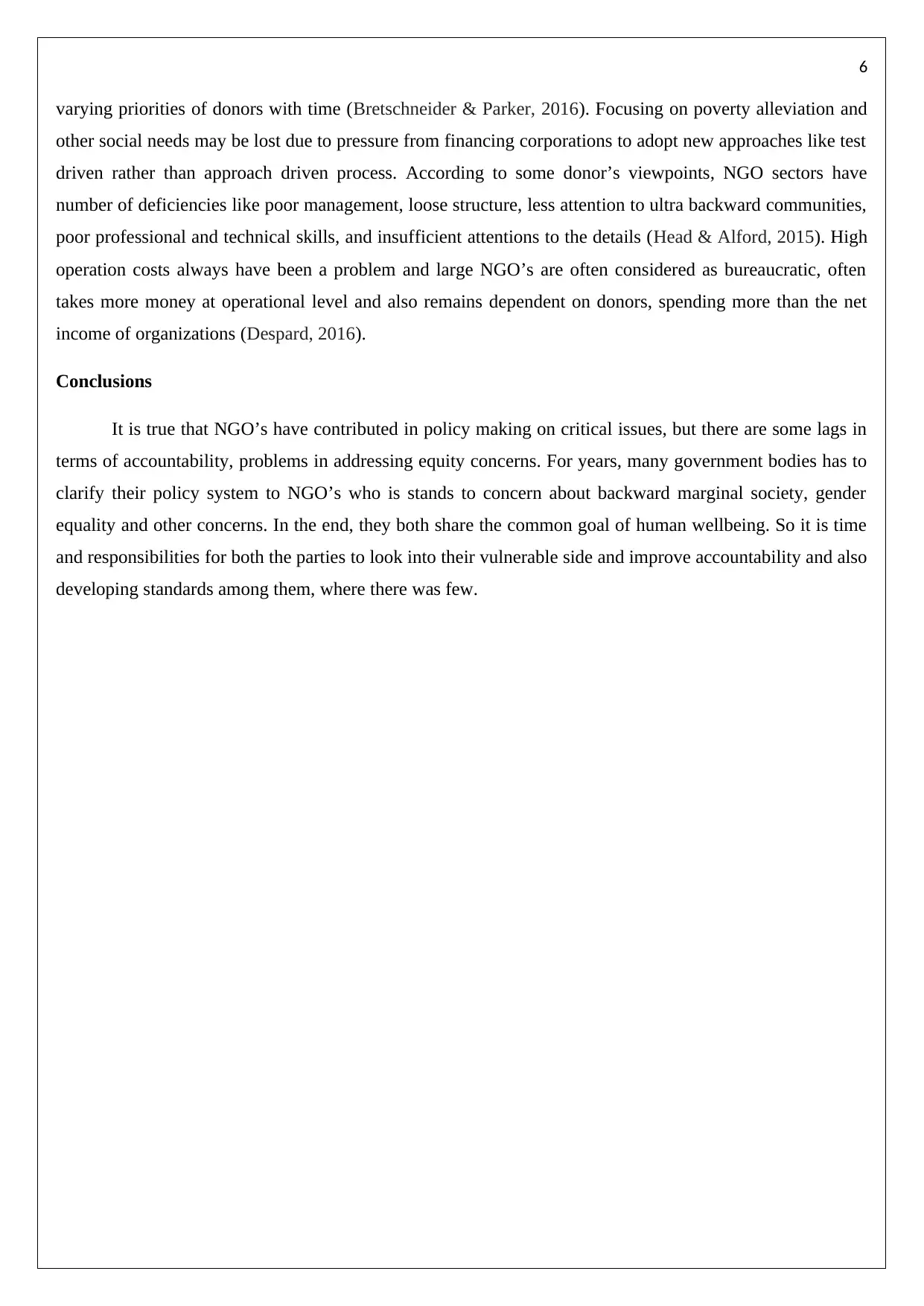
6
varying priorities of donors with time (Bretschneider & Parker, 2016). Focusing on poverty alleviation and
other social needs may be lost due to pressure from financing corporations to adopt new approaches like test
driven rather than approach driven process. According to some donor’s viewpoints, NGO sectors have
number of deficiencies like poor management, loose structure, less attention to ultra backward communities,
poor professional and technical skills, and insufficient attentions to the details (Head & Alford, 2015). High
operation costs always have been a problem and large NGO’s are often considered as bureaucratic, often
takes more money at operational level and also remains dependent on donors, spending more than the net
income of organizations (Despard, 2016).
Conclusions
It is true that NGO’s have contributed in policy making on critical issues, but there are some lags in
terms of accountability, problems in addressing equity concerns. For years, many government bodies has to
clarify their policy system to NGO’s who is stands to concern about backward marginal society, gender
equality and other concerns. In the end, they both share the common goal of human wellbeing. So it is time
and responsibilities for both the parties to look into their vulnerable side and improve accountability and also
developing standards among them, where there was few.
varying priorities of donors with time (Bretschneider & Parker, 2016). Focusing on poverty alleviation and
other social needs may be lost due to pressure from financing corporations to adopt new approaches like test
driven rather than approach driven process. According to some donor’s viewpoints, NGO sectors have
number of deficiencies like poor management, loose structure, less attention to ultra backward communities,
poor professional and technical skills, and insufficient attentions to the details (Head & Alford, 2015). High
operation costs always have been a problem and large NGO’s are often considered as bureaucratic, often
takes more money at operational level and also remains dependent on donors, spending more than the net
income of organizations (Despard, 2016).
Conclusions
It is true that NGO’s have contributed in policy making on critical issues, but there are some lags in
terms of accountability, problems in addressing equity concerns. For years, many government bodies has to
clarify their policy system to NGO’s who is stands to concern about backward marginal society, gender
equality and other concerns. In the end, they both share the common goal of human wellbeing. So it is time
and responsibilities for both the parties to look into their vulnerable side and improve accountability and also
developing standards among them, where there was few.
⊘ This is a preview!⊘
Do you want full access?
Subscribe today to unlock all pages.

Trusted by 1+ million students worldwide
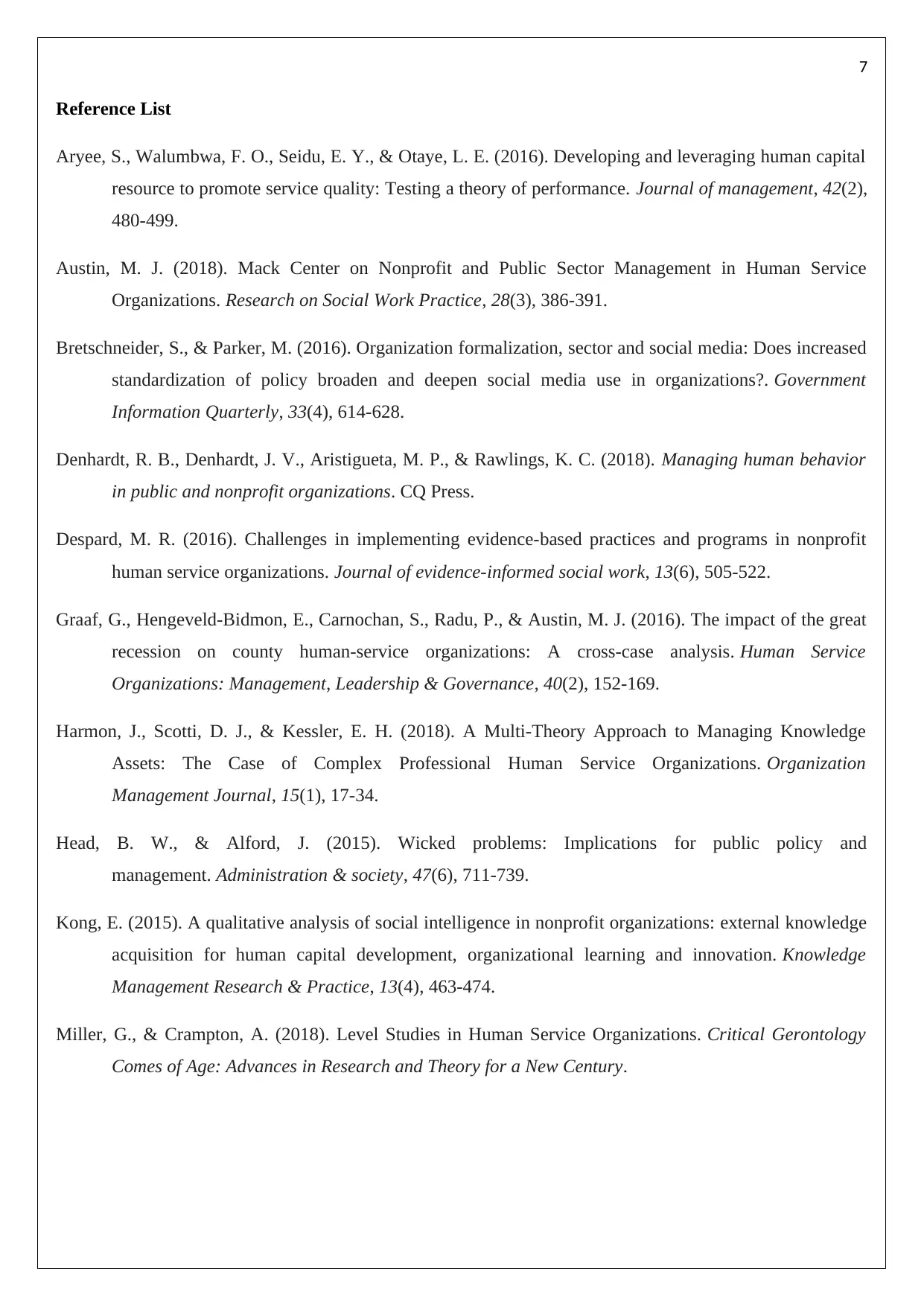
7
Reference List
Aryee, S., Walumbwa, F. O., Seidu, E. Y., & Otaye, L. E. (2016). Developing and leveraging human capital
resource to promote service quality: Testing a theory of performance. Journal of management, 42(2),
480-499.
Austin, M. J. (2018). Mack Center on Nonprofit and Public Sector Management in Human Service
Organizations. Research on Social Work Practice, 28(3), 386-391.
Bretschneider, S., & Parker, M. (2016). Organization formalization, sector and social media: Does increased
standardization of policy broaden and deepen social media use in organizations?. Government
Information Quarterly, 33(4), 614-628.
Denhardt, R. B., Denhardt, J. V., Aristigueta, M. P., & Rawlings, K. C. (2018). Managing human behavior
in public and nonprofit organizations. CQ Press.
Despard, M. R. (2016). Challenges in implementing evidence-based practices and programs in nonprofit
human service organizations. Journal of evidence-informed social work, 13(6), 505-522.
Graaf, G., Hengeveld-Bidmon, E., Carnochan, S., Radu, P., & Austin, M. J. (2016). The impact of the great
recession on county human-service organizations: A cross-case analysis. Human Service
Organizations: Management, Leadership & Governance, 40(2), 152-169.
Harmon, J., Scotti, D. J., & Kessler, E. H. (2018). A Multi-Theory Approach to Managing Knowledge
Assets: The Case of Complex Professional Human Service Organizations. Organization
Management Journal, 15(1), 17-34.
Head, B. W., & Alford, J. (2015). Wicked problems: Implications for public policy and
management. Administration & society, 47(6), 711-739.
Kong, E. (2015). A qualitative analysis of social intelligence in nonprofit organizations: external knowledge
acquisition for human capital development, organizational learning and innovation. Knowledge
Management Research & Practice, 13(4), 463-474.
Miller, G., & Crampton, A. (2018). Level Studies in Human Service Organizations. Critical Gerontology
Comes of Age: Advances in Research and Theory for a New Century.
Reference List
Aryee, S., Walumbwa, F. O., Seidu, E. Y., & Otaye, L. E. (2016). Developing and leveraging human capital
resource to promote service quality: Testing a theory of performance. Journal of management, 42(2),
480-499.
Austin, M. J. (2018). Mack Center on Nonprofit and Public Sector Management in Human Service
Organizations. Research on Social Work Practice, 28(3), 386-391.
Bretschneider, S., & Parker, M. (2016). Organization formalization, sector and social media: Does increased
standardization of policy broaden and deepen social media use in organizations?. Government
Information Quarterly, 33(4), 614-628.
Denhardt, R. B., Denhardt, J. V., Aristigueta, M. P., & Rawlings, K. C. (2018). Managing human behavior
in public and nonprofit organizations. CQ Press.
Despard, M. R. (2016). Challenges in implementing evidence-based practices and programs in nonprofit
human service organizations. Journal of evidence-informed social work, 13(6), 505-522.
Graaf, G., Hengeveld-Bidmon, E., Carnochan, S., Radu, P., & Austin, M. J. (2016). The impact of the great
recession on county human-service organizations: A cross-case analysis. Human Service
Organizations: Management, Leadership & Governance, 40(2), 152-169.
Harmon, J., Scotti, D. J., & Kessler, E. H. (2018). A Multi-Theory Approach to Managing Knowledge
Assets: The Case of Complex Professional Human Service Organizations. Organization
Management Journal, 15(1), 17-34.
Head, B. W., & Alford, J. (2015). Wicked problems: Implications for public policy and
management. Administration & society, 47(6), 711-739.
Kong, E. (2015). A qualitative analysis of social intelligence in nonprofit organizations: external knowledge
acquisition for human capital development, organizational learning and innovation. Knowledge
Management Research & Practice, 13(4), 463-474.
Miller, G., & Crampton, A. (2018). Level Studies in Human Service Organizations. Critical Gerontology
Comes of Age: Advances in Research and Theory for a New Century.
1 out of 7
Related Documents
Your All-in-One AI-Powered Toolkit for Academic Success.
+13062052269
info@desklib.com
Available 24*7 on WhatsApp / Email
![[object Object]](/_next/static/media/star-bottom.7253800d.svg)
Unlock your academic potential
Copyright © 2020–2025 A2Z Services. All Rights Reserved. Developed and managed by ZUCOL.





